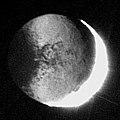Fichier:Iapetus by Saturnlight.jpg
Iapetus_by_Saturnlight.jpg (400 × 400 pixels, taille du fichier : 35 kio, type MIME : image/jpeg)
Historique du fichier
Cliquer sur une date et heure pour voir le fichier tel qu'il était à ce moment-là.
| Date et heure | Vignette | Dimensions | Utilisateur | Commentaire | |
|---|---|---|---|---|---|
| actuel | 19 décembre 2015 à 05:04 |  | 400 × 400 (35 kio) | PlanetUser | converted from TIFF |
| 4 avril 2005 à 20:20 |  | 400 × 400 (22 kio) | Smartech~commonswiki | Iapetus, a moon of Saturn, with its dark side illuminated by reflected light from Saturn {{PD-USGov-NASA}} '''Original caption released with image:''' New details on Iapetus are illuminated by reflected light fro |
Utilisation du fichier
La page suivante utilise ce fichier :
Usage global du fichier
Les autres wikis suivants utilisent ce fichier :
- Utilisation sur ar.wikipedia.org
- Utilisation sur bg.wikipedia.org
- Utilisation sur ca.wikipedia.org
- Utilisation sur ko.wikipedia.org
- Utilisation sur lv.wikipedia.org
- Utilisation sur ms.wikipedia.org
- Utilisation sur sv.wikipedia.org
- Utilisation sur zh.wikipedia.org


